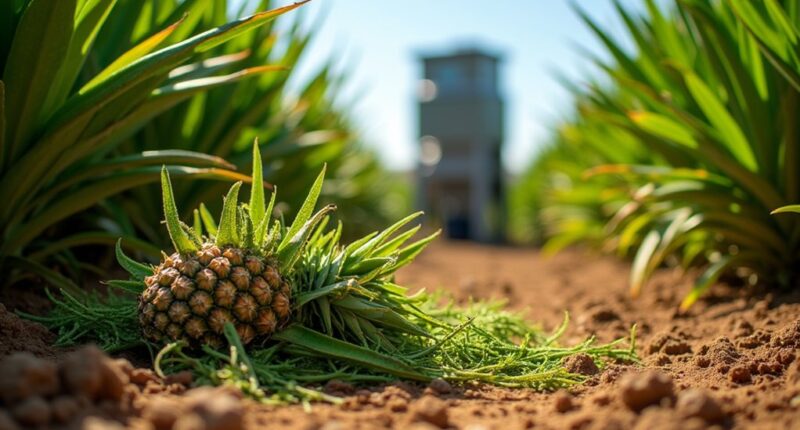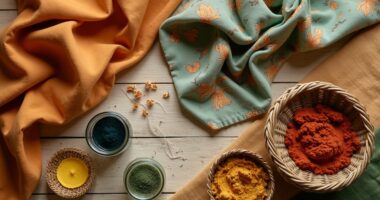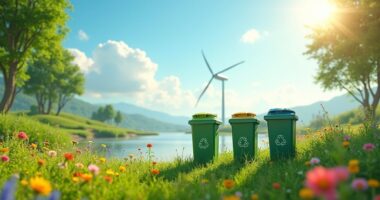Piñatex, a groundbreaking textile made from pineapple leaf waste, turns agricultural leftovers into a chic alternative to leather. It repurposes 40,000 tons of discarded leaves annually, helping the environment while supporting farmers with extra income. While there are hurdles, like durability concerns and supply challenges, innovations in production are making waves. Imagine waiving goodbye to harmful chemicals and land use—now that’s savvy! Stick around to discover more about this sustainable superstar and its growing impact.
Quick Overview
- Piñatex repurposes 40,000 tons of pineapple leaf waste annually, minimizing environmental impact and promoting sustainability in textile production.
- The production process incorporates agricultural waste and circular economy principles, transforming byproducts into resource-efficient textiles.
- Farmers earn 2€ per square meter from Piñatex, creating economic opportunities and job growth in rural communities across the Philippines, Costa Rica, and Indonesia.
- Challenges in scaling include supply issues and durability limitations, necessitating innovative partnerships and machinery for efficient production.
- Piñatex’s biodegradable nature and integration of polylactic acid and polyurethane enhance its properties while addressing the environmental impact of conventional textiles.
Sustainable Production and Environmental Benefits
In the domain of sustainable fashion, Piñatex—a unique leather alternative derived from pineapple leaves—stands out like a beacon of hope.
By repurposing agricultural waste, Piñatex transforms pineapple leaves into a resource-efficient textile, sidestepping the need for extra land, water, or harmful chemicals. This innovative material is developed as a response to the environmental impact of leather production. With 40,000 tons of waste from pineapple leaves generated annually, Piñatex not only utilizes this byproduct but also supports rural communities in the Philippines. The fashion industry’s shift toward responsible approaches like Piñatex represents a crucial step in addressing the sector’s significant environmental footprint.
Repurposing agricultural waste, Piñatex turns pineapple leaves into a sustainable textile, reducing the need for land and harmful chemicals.
The production process boasts low energy and water use compared to traditional leather tanning, while the biodegradable nature of Piñatex means it won’t linger in landfills like that questionable fruitcake from last Christmas.
With no animals harmed and minimal environmental impact, Piñatex is not just a clever alternative; it’s a sustainable win for the planet and fashion enthusiasts alike!
Economic Impact and Community Engagement
Transforming agricultural waste into a thriving economic opportunity, Piñatex not only provides a sustainable alternative to traditional leather but also boosts the livelihoods of farming communities. Farmers earn approximately 2€ per square meter of Piñatex, creating a new revenue stream from what was once discarded. With the market projected to grow substantially, job creation in rural areas flourishes, strengthening local networks. Countries like the Philippines, Costa Rica, and Indonesia are joining the Piñatex revolution. As brands embrace this innovative material, the demand for eco-friendly products rises, proving that sustainability can be both fashionable and financially rewarding. This growth is further supported by the projected market value of US$ 108.7 million by 2031, highlighting the economic potential of this sustainable textile. Unlike conventional textiles that often have high water consumption, Piñatex production significantly reduces environmental impact while maintaining quality. Integrating a circular economy approach, Piñatex adds economic value to agricultural waste, benefiting both the environment and local communities.
Challenges and Innovations in Scaling Production
As the demand for Piñatex continues to grow, the challenges of scaling production loom large, much like a pineapple plant thriving under the tropical sun.
Ensuring a steady supply of pineapple leaves is tricky; it takes about 25 kilos—equivalent to 460 leaves from 15 plants—for just one square meter of material. Pineapple leather production provides additional income for farmers, supporting a circular economy with minimal water use. Moreover, agricultural waste from pineapple leaves is effectively transformed into valuable resources, enhancing the sustainability aspect of production.
Ananas Anam combats this with partnerships and innovative machinery to streamline processing. The company exemplifies the circular economy principles by designing products that minimize waste through continuous material reuse.
While Piñatex is more sustainable than traditional leather, its mix of polylactic acid and polyurethane creates a biodegradable conundrum.
Furthermore, durability still lags behind high-quality animal leather, leaving room for improvement and creative solutions in the industry.









